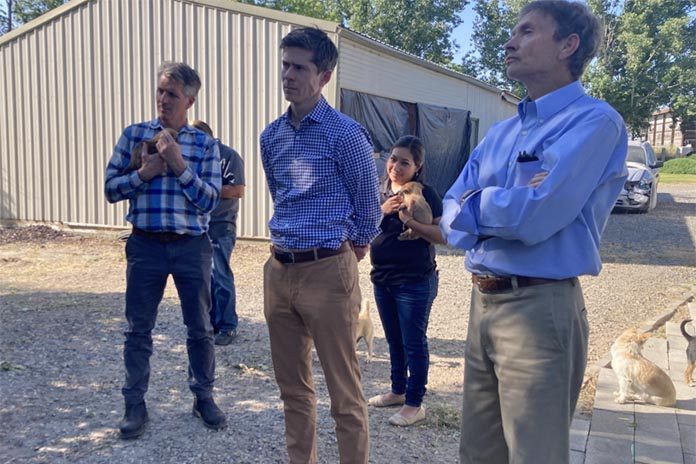
By Alex Baumhardt
More than three years ago, eight national and Oregon-based environmental nonprofits petitioned the federal Environmental Protection Agency to do something about nitrate-contaminated water in northeast Oregon.
Then, they waited.
On Thursday, EPA officials finally met with members of Food & Water Watch who first sent a petition to the EPA – along with Columbia Riverkeeper, Friends of Family Farmers, Humane Voters Oregon, WaterWatch of Oregon, Animal Legal Defense Fund, Center for Biological Diversity, the Center for Food Safety and private citizen Eileen Laramore – on Jan. 16, 2020.
The meeting Thursday was “long past overdue,” said Tyler Lobdell, a staff attorney for Food & Water Watch. Regional EPA officials, including Edward Kowlaski, deputy regional administrator, and Jeff KenKnight, water enforcement manager, met with group leaders in Boardman in Morrow County. More than 200 household wells in the county have tested above the EPA’s limit for nitrate in drinking water.
“What we’re asking of EPA is to start taking action, as requested in our petition for emergency intervention back in 2020,” Lobdell said.
In their petition, the groups asked that the EPA intervene under its emergency powers established in the Safe Drinking Water Act. This allows the agency to take “primacy” over state agencies and to regulate and enforce penalties against water polluters. It could also direct more staff and financial resources to delivering safe water to homes in need and installing specialized filters where needed.
The groups wrote in their petition that for more than 30 years the state had failed to stop nitrate pollution from farm fertilizers, animal manure and industrial wastewater from polluting an aquifer that thousands of people in Morrow and Umatilla counties depend on for drinking water.
“Oregon officials have effectively abandoned their responsibility to protect Oregon’s citizens,” they wrote in the 32-page document.
Bill Dunbar, an EPA spokesman, said agency officials agreed to the meeting with the petitioners to listen to their concerns and because of their persistence.
“The petitioners have been banging the door for a meeting for a long time,” he said. “The goal is to listen. They wanted to talk.”
The EPA has met with leaders of state agencies quarterly since last fall to discuss their progress on getting people clean drinking water and holding polluters to account, but Lobdell said the state has been too slow, especially when it comes to getting information to people who might have contaminated wells.
“Unfortunately, the state really hasn’t met any of those expectations,” Lobdell said. “At this point we need the EPA to really ramp up its pressure on the state and accelerate what’s in motion.”
The Oregon Health Authority has only tested about 4% of the private domestic wells in Morrow and Umatilla Counties and provided 12 filters to households with high nitrate levels. There are 4,500 domestic wells providing what could be contaminated drinking and cooking water to households in the two counties.
Members of the community with contaminated drinking water and the nonprofit Oregon Rural Action also met with the petitioners and EPA Thursday. The agency previously met with community members and Oregon Rural Action leaders in March, including EPA’s regional leader, Casey Sixkiller.
Dunbar said EPA leaders don’t yet intend to intervene, but they will continue quarterly discussions with the state agencies involved in responding to the water contamination.
“We expect the EPA to do something,” Lobdell said. “Status quo is not something we’re going to accept.”
This story first appeared in the Oregon Capital Chronicle.









God lord, it is about time they step up and do the right thing. Help these people with bad drinking water.
Federal government being able to take “primacy” over state and local government, is rarely (if ever) a good thing. I don’t think this is going to turn out the way everyone is imagining that it is…..
It’s turning out just they way I thought it would. Years are passing when the water that people need every day has been polluted for the sake of corporate profit and nothing is being done about it. Looks like they are planning on some more years of the same. Something besides the water is stinky.